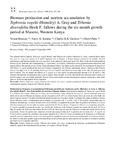Biomass production and nutrient accumulation by Tephrosia vogelii (Hemsley) A. Gray and Tithonia diversifolia Hook F. fallows during the six-month growth period at Maseno, Western Kenya
Date
1999Author
Rutunga, Venant
Karanja, Nancy K
Gachene, C K K
Palm, Cheryl
Type
ArticleLanguage
enMetadata
Show full item recordAbstract
Two planted fallows namely, Tephrosia vogelii Hook F. and Tithonia diversifolia (Hemsley) A. Gray, a natural fallow and a
Zea mays L. crop were grown on N and P depleted soils at Maseno in Kenya during a period of six months. Growth
performance and biomass production were assessed. Roots and aerial plant parts grew fast. Most of the shrubs had produced
flowers by the 165th day after transplanting. T. vogelii and T. diversifolia yielded more above ground biomass than maize and
natural fallow. The amount of roots in the shrub and natural fallows was higher in the topsoil (0–30 cm) than in the deep layer
(30–45cm). T. vogelii produced the least root biomass compared to the Tithonia and natural fallows. Tephrosia and Tithonia
leaves were high in N, K, Ca and Mg, Tephrosia roots in N and K, and Tephrosia stems high in Ca only. All plant parts had
low P content. The six month-old fallows of T. vogelii or T. diversifolia accumulated high amount of N, K and Ca. This
biomass and nutrient accumulation may even be higher where rainfall is evenly distributed and sufficient and if initial soil
fertility status is not very highly depleted. Tithonia leaves had a higher proton consumption capacity compared to other plant
parts or Tephrosia and natural fallow materials. .
Citation
Biotechnology, Agronomy, Society and Environment 1999 3 (4), 237-246Publisher
Department of soil science, University of Nairobi
Subject
FallowTephrosia vogelii
Tithonia diversifolia
Zea mays
Biomass production
Nutrient accumulation
Proton consumption capacity
Tropical soil
Nitosols
Kenya
Description
Journal article

